Just as the afternoon is the warmest part of the day on Earth, the space rock develops a warm region that radiates infrared light in its maximum amount during afternoon on the asteroid. That outgoing infrared radiation provides a gentle but firm jet-like push to the asteroid. The direction of the asteroid’s spin determines whether “afternoon” is either forward or rearward of its direction of motion. If the hot spot is forward of the direction of motion, the infrared push will slow the asteroid’s orbital speed, and if the hot spot is rearward of the direction of motion, it will speed up the orbital motion. This effect, over time, can make a significant change in the orbit. This is called the Yarkovsky Effect, after the engineer who first identified it.
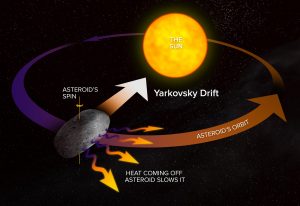
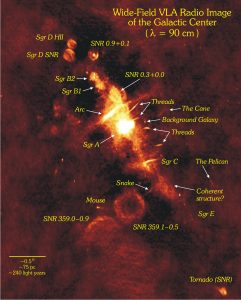
Labeled Map of Our Galaxy’s Center
The diagonal line of bright objects in this image of the heart of our Milky Way Galaxy are all powerful sources of radio waves. The bright center is the home of the supermassive black hole, Sagittarius A*. The dense, bright circles are the nurseries of new, hot stars and the bubbles are the graveyards of exploded, massive stars. The thread-like shapes are not yet understood, but probably trace powerful magnetic field lines. This giant image was assembled from observations made by the Very Large Array (VLA).
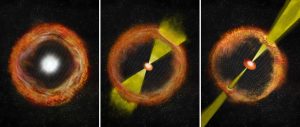
Strange Supernova is ‘Missing Link’ in Gamma-Ray Burst Connection
In an ordinary core-collapse supernova with no “central engine,” ejected material expands outward nearly spherically, left. At right, a strong central engine propels jets of material at nearly the speed of light and generates a gamma-ray burst (GRB). The center panel shows an intermediate supernova like SN 2012ap, with a weak central engine, weak jets, and no GRB.
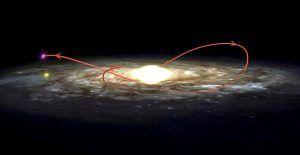
Tracking a Black Hole
Orbital path (red line) of black hole XTE J1118+480 and its companion through the Milky Way Galaxy over the past 230 million years. Yellow circle indicates the Sun’s current position.
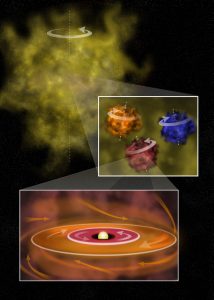
Wildly Spinning Disks
TOP: A huge star-forming region is rotating globally (white arrow). This large region can make multiple stellar systems. MIDDLE: Three protostars form deep in the collapsing cloud. The collapse causes eddies, allowing newly-forming stars to rotate in different directions and at different speeds (see arrows). BOTTOM: One protostellar cloud collapses further into a disk-like structure that rotates counter-clockwise (white arrows) about the newly-formed protostar. The protostar siphons material from a passing protostellar cloud rotating in the opposite direction, causing the outer part of the disk to rotate clockwise (yellow arrows). Eventually, planets will form, with the outer planets orbiting the star in the opposite direction from the inner planets.
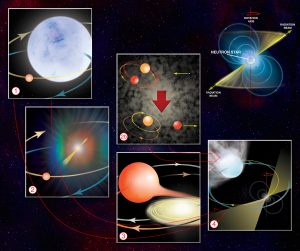
How to Make a Millisecond Pulsar
The diagram outlines each step needed to create a pulsar with a superfast spin. The Standard Scenario (1-4):
1. A massive supergiant star and a “normal” Sun-like star orbit each other in a binary star system.
2. The massive star exhausts its nuclear fuel and explodes in a supernova, leaving a neutron star as its remnant. For several tens of millions of years, that neutron star is likely active as a radio pulsar. Eventually it slows down, turns off as a pulsar and becomes simply a cooling neutron star.
3. After billions of years, and if the binary survived the supernova, the lower-mass star evolves and expands into a red giant. Material from the star spills into a disk around the neutron star and eventually onto the neutron star surface in a process known as “accretion.” Accretion transfers angular momentum to the neutron star and makes it spin more rapidly. During this process, the system is visible as an X-ray binary.
4. Once accretion ends, the neutron star is spinning very rapidly and emerges as a millisecond radio pulsar. This process is known as “recycling.” Strong “winds” from the pulsar slowly erode away the companion star, which can eclipse the pulsar’s radio emission.
But in a globular cluster (2b)…
There are so many stars packed so densely together that interactions between ancient “dead” neutron stars and normal stellar binaries can occur (top). When that happens, in a process called “exchange,” the lowest mass star is usually ejected from the binary and the neutron star replaces it (bottom). Once the remaining normal star evolves into a red giant, the rest of the standard “recycling” scenario (3-4) takes place. These interactions and exchanges explain why globular clusters have so many more millisecond pulsars per unit mass than the Galactic disk.





